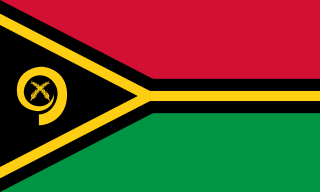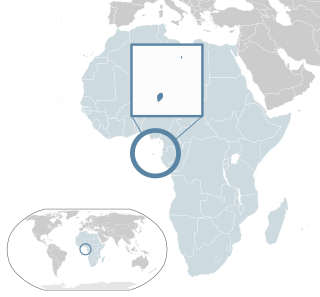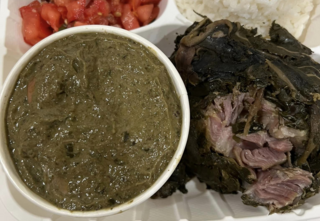
Brazilian cuisine is the set of cooking practices and traditions of Brazil, and is characterized by European, Amerindian, African, and Asian influences. It varies greatly by region, reflecting the country's mix of native and immigrant populations, and its continental size as well. This has created a national cuisine marked by the preservation of regional differences.

Poi is a traditional staple food in the Polynesian diet, made from taro.

Puerto Rican cuisine has its roots in the cooking traditions and practices of native Taínos, Spaniard and African ancestors.

Trinidad and Tobago has a unique history and its food is influenced by Indian-South Asian, West African, Creole, European, American, Chinese, Amerindian, and Latin American culinary styles. Trinidadian and Tobagonian food is dominated by a wide selection of dishes, most notably, doubles, pelau, callaloo and curried crab and dumplings. Trinidad and Tobago is also known for its prepared provisions, such as dasheen, sweet potato, eddoes, cassava, yam, soups and stews, also known as blue food across the country. Corresponding to the Blue Food Day event held annually in Trinidad and Tobago.

Taro is a root vegetable. It is the most widely cultivated species of several plants in the family Araceae that are used as vegetables for their corms, leaves, stems and petioles. Taro corms are a food staple in African, Oceanic, East Asian, Southeast Asian and South Asian cultures. Taro is believed to be one of the earliest cultivated plants.

Haupia is the Hawaiian name for a traditional coconut pudding found throughout Polynesia.

Ghanaian cuisines refer to the meals of the Ghanaian people. The main dishes of Ghana are organized around starchy staple foods, which goes with either sauce or soup accompanied with a source of protein. The main ingredients for the vast majority of soups and stews are; tomatoes, hot peppers and onions. Most Ghanaian soups and stews are red or orange in appearance as a result of the main ingredients used.

Maldivian cuisine, also called Dhivehi cuisine, is the cuisine of the Republic of Maldives and of Minicoy, India. The traditional cuisine of Maldivians is based on three main items and their derivatives: coconuts, fish and starches.

The cuisine of Vanuatu incorporates fish, root vegetables such as taro and yams, fruits, and vegetables. Most island families grow food in their gardens, and food shortages are rare. Papayas, pineapples, mangoes, plantains, and sweet potatoes are abundant through much of the year. Coconut milk and cream are used to flavor many dishes. Most food is cooked using hot stones or through boiling and steaming; little food is fried. Since Vanuatu is one of the few South Pacific regions influenced by the outside world, Vanuatu's food has a multicultural nature.

Fijian cuisine has long-consisted of primarily foraged and farm-grown food. Although rice, wheat, and tea all became staples during Fiji's colonial era, native Fijians still eat primarily tubers and coconuts. The cuisine of Fiji is known for its seafood and various green vegetables, including ''ota'', a young forest fern, and ''bele'', a plant that resembles spinach.

A great variety of cassava-based dishes are consumed in the regions where cassava is cultivated, and the ingredient is included many national or ethnic specialities.

Pascuense cuisine, otherwise known as Easter Island cuisine or Rapa Nui cuisine incorporates the influences of the indigenous Rapa Nui people and Latin America. Notable ingredients include seafood such as fish, octopus (heke), eel, sea snails (pipi) and crustaceans (lobster), as well as sweet potato, taro, banana, pineapple, coconut, pumpkin, and poultry, pork and lamb meat.

The cuisine of Solomon Islands has developed over 5,000 years of inhabitation and external influences. From the Spanish, the islands received cattle; from the Asians and Indians, spices, exotic vegetables and fruit.
The Cayman Islands are a group of islands situated in the Caribbean Sea just between Cuba and Honduras. After being colonized first by Jamaica and then by the British, Cayman Islands remained under British dependency since 1962. Traditional Cayman Islands cuisine is very tied to Jamaican cuisine and they also kept British influences in their cooking, but you can as well find a large variety of international dishes with a local twist. As for traditional dishes the main ingredients are coconut, plantain, cassava, yams, rice and peas. Jamaican cuisine enriched Cayman’s cuisine by offering a large variety of spices such as jerk, curry and other exotic seasonings. The humid soil provides a large variety of exotic fruits and vegetables such as yellow squash, avocados, callaloo, cassava, calabash, spring onions, pineapples, tomatoes, peas, chili, peppers a great range of citrus fruits such as oranges, lemons, limes, grapefruits, bananas and plantains, sweet potatoes, yams and mangoes.

Run down, also referred to as rundown, run dun, rondón, fling-me-far, and fling mi for, is a stew dish in Jamaican cuisine and Tobago cuisine. The traditional Jamaican dish is eaten in several Latin American countries that share a coast with the Caribbean Sea.

Santomean cuisine comprises the cuisine, dishes and foods of São Tomé and Príncipe, a Portuguese-speaking island nation in the Gulf of Guinea, off the western equatorial coast of Central Africa. The country consists of two archipelagos around the two main islands: São Tomé and Príncipe, located about 140 kilometres (87 mi) apart and about 250 and 225 kilometres, respectively, off the northwestern coast of Gabon.

Lūʻau, Luʻau, Laulau, Lū, Rourou, Rukau, Fāfā, Hāhā, and Palusami are all related dishes found throughout Polynesia based on the use of taro leaves as a primary ingredient. While taro generally is known as a root vegetable for its starchy corms, the leaves are consumed as well. The base recipe is vegetarian, historically. Most often, coconut milk was added, and later meat or seafood. The texture of the dish range from a thick soup to a dense cake.

Native Hawaiian cuisine refers to the traditional Hawaiian foods that predate contact with Europeans and immigration from East and Southeast Asia. The cuisine consisted of a mix of indigenous plants and animals as well as plants and animals introduced by Polynesian voyagers, who became the Native Hawaiians.
















